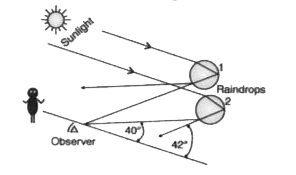Write the conditions for observing a rainbow Show, by drawing suitable diagrams, how one understands the formation of a rainbow. Solution in Kannada
The conditions for observing a rainbow are :

(i) The sun comes out after a rainfall.
(ii) The observer stands with the sun towards his / her back.
Formation of a rainbow :
The rays of light reach the observer through a refraction, followed by a refraction.
Figure shows red light,from drop 1 and voilet light from drop 2, reaching the observers eye.
Topper's Solved these Questions
- RAY OPTICS AND OPTICAL INSTRUMENTSBOOK - OSWAAL PUBLICATIONCHAPTER - RAY OPTICS AND OPTICAL INSTRUMENTSEXERCISE - TOPIC-1(SHORT ANSWER TYPE QUESTIONS-2)
6 Videos
- RAY OPTICS AND OPTICAL INSTRUMENTSBOOK - OSWAAL PUBLICATIONCHAPTER - RAY OPTICS AND OPTICAL INSTRUMENTSEXERCISE - TOPIC-1(LONG ANSWER TYPE QUESTIONS)
7 Videos
- RAY OPTICS AND OPTICAL INSTRUMENTSBOOK - OSWAAL PUBLICATIONCHAPTER - RAY OPTICS AND OPTICAL INSTRUMENTSEXERCISE - TOPIC-3(Numerical Problems)
3 Videos
- NUCLEIBOOK - OSWAAL PUBLICATIONCHAPTER - NUCLEIEXERCISE - TOPIC -2 (Numerical Problems)
3 Videos
- Sample Paper 1BOOK - OSWAAL PUBLICATIONCHAPTER - Sample Paper 1EXERCISE - Exercise
36 Videos
Similar Questions
Derive the relation f=R/2 in the case of a concave mirror.
View SolutionDerive the expression for refractive index of the material of the prism in terms of angle of the prism and angle of minimum deviation.
View SolutionThe total magnification produced by a compound microscope is 20. The magnification produced by the eye piece is 5. The microscope is focussed on a certain object. The distance between the objective and eyepiece is observed to be 14cm.
If the least distance of distinct vision is 20cm, calculate the focal length of the objective and the eye piece.
View SolutionThe half life of 38Sr90 isotope is 28 years. What is the rate of disintegration of 15 mg of this isotope? (Given Avogadro No =6.023×1023)
View SolutionCharges of 10μC and 15μC are separated by a certain distance. Which charge repels the other with a greater force?
View Solution(a) Draw a diagram to show the refraction of light through a glass prism. On this diagram, mark (i) incident ray (ii) emergent ray, and (iii) angle of deviation. (b) What is a rainbow ? What are the two conditions necessary for the formation of a rainbow in the sky ? (c) What acts as tiny prisms in the formation of a rainbow ? (d) Name the process which is involved in the formation of a rainbow. (e) What are the seven colours seen in a rainbow ?
View SolutionWhen and where do we see a rainbow? How is a rainbow formed? Draw a labelled diagram to illustrate the formation of a rainbow.
View SolutionWhat is a rainbow? Draw a labelled diagram to show the formation of a rainbow.
View Solutionप्राथमिक इंद्रधनुष के निर्माण को प्रदर्शित करने वाला रेखाचित्र खींचिए तथा व्याख्या कीजिए कि किन कोणों पर प्राथमिक इंद्रधनुष दृश्य होता है?
View SolutionDraw a neat labelled diagram to show (i) primary rainbow and (ii) secondary rainbow.
View SolutionWhat is the difference between the priamry and secondary rainbow? What are the conditions to observe a rainbow?
View SolutionWhat is a rainbow ? Draw a labelled diagram to show the formation of rainbow. OR Describe the formation of rainbow in the sky with the help of a diagram.
View SolutionWrite the conditions for observing a rainbow. Show, by drawing suitable diagrams, how one understands the formation of rainbow.
View SolutionDraw a labelled diagram to explain the formation of a rainbow in the sky.
View SolutionWhat is a rainbow? Draw a labelled diagram to show the formation of a rainbow.
View Solution
